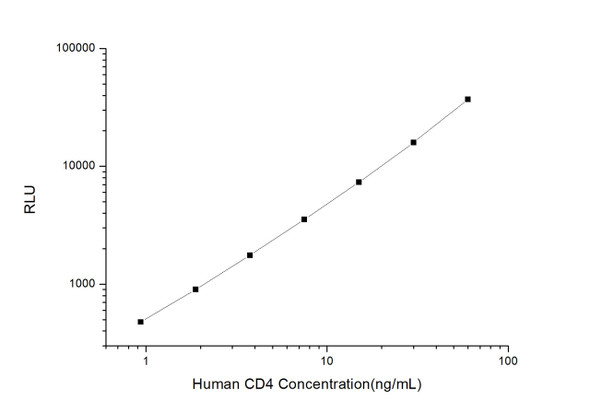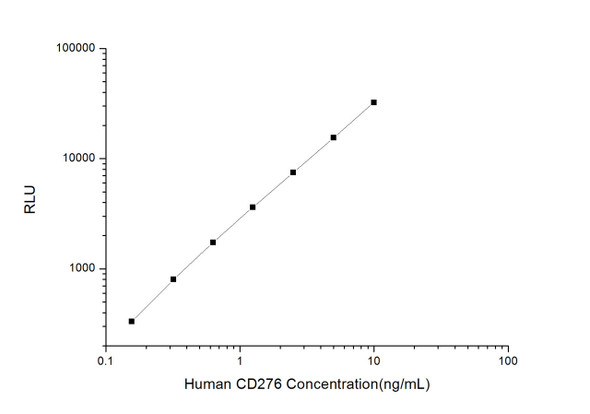Human Immunology ELISA Kits 1
Human CD3d (Cluster of Differentiation 3d) CLIA Kit (HUES00217)
- SKU:
- HUES00217
- Product Type:
- ELISA Kit
- ELISA Type:
- CLIA Kit
- Size:
- 96 Assays
- Sensitivity:
- 18.75pg/mL
- Range:
- 31.25-2000pg/mL
- ELISA Type:
- Sandwich
- Synonyms:
- CD3-DELTA, T3D, T-cell surface glycoprotein CD3 delta chain
- Reactivity:
- Human
- Sample Type:
- Serum, plasma and other biological fluids
- Research Area:
- Immunology
Description
| Assay type: | Sandwich |
| Format: | 96T |
| Assay time: | 4.5h |
| Reactivity: | Human |
| Detection method: | Chemiluminescence |
| Detection range: | 31.25-2000 pg/mL |
| Sensitivity: | 18.75 pg/mL |
| Sample volume: | 100µL |
| Sample type: | Serum, plasma and other biological fluids |
| Repeatability: | CV < 15% |
| Specificity: | This kit recognizes Human CD3d in samples. No significant cross-reactivity or interference between Human CD3d and analogues was observed. |
This kit uses Sandwich-CLIA as the method. The micro CLIA plate provided in this kit has been pre-coated with an antibody specific to Human CD3d. Standards or samples are added to the appropriate micro CLIA plate wells and combined with the specific antibody. Then a biotinylated detection antibody specific for Human CD3d and Avidin-Horseradish Peroxidase (HRP) conjugate are added to each micro plate well successively and incubated. Free components are washed away. The substrate solution is added to each well. Only those wells that contain Human CD3d, biotinylated detection antibody and Avidin-HRP conjugate will appear fluorescence. The Relative light unit (RLU) value is measured spectrophotometrically by the Chemiluminescence immunoassay analyzer. The RLU value is positively associated with the concentration of Human CD3d. The concentration of Human CD3d in the samples can be calculated by comparing the RLU of the samples to the standard curve.
| UniProt Protein Function: | CD3D: a T cell surface glycoprotein that is a component of the T cell antigen receptor. A defect in this protein causes a severe combined immunodeficiency characterized by the absence of T cells but normal B cells. Contains 1 ITAM domain. |
| UniProt Protein Details: | Protein type:Membrane protein, integral; Receptor, misc. Chromosomal Location of Human Ortholog: 11q23 Cellular Component: T cell receptor complex; cytoplasm; plasma membrane; integral to membrane; alpha-beta T cell receptor complex Molecular Function:transmembrane receptor activity; protein heterodimerization activity; transcription coactivator activity Biological Process: regulation of immune response; cell surface receptor linked signal transduction; T cell costimulation; positive regulation of transcription from RNA polymerase II promoter; T cell receptor signaling pathway; T cell differentiation; positive thymic T cell selection Disease: Immunodeficiency 19 |
| NCBI Summary: | The protein encoded by this gene is part of the T-cell receptor/CD3 complex (TCR/CD3 complex) and is involved in T-cell development and signal transduction. The encoded membrane protein represents the delta subunit of the CD3 complex, and along with four other CD3 subunits, binds either TCR alpha/beta or TCR gamma/delta to form the TCR/CD3 complex on the surface of T-cells. Defects in this gene are a cause of severe combined immunodeficiency autosomal recessive T-cell-negative/B-cell-positive/NK-cell-positive (SCIDBNK). Two transcript variants encoding different isoforms have been found for this gene. Other variants may also exist, but the full-length natures of their transcripts has yet to be defined. [provided by RefSeq, Feb 2009] |
| UniProt Code: | P04234 |
| NCBI GenInfo Identifier: | 115985 |
| NCBI Gene ID: | 915 |
| NCBI Accession: | P04234. 1 |
| UniProt Secondary Accession: | P04234,A8MVP6, |
| UniProt Related Accession: | P04234 |
| Molecular Weight: | 171 |
| NCBI Full Name: | T-cell surface glycoprotein CD3 delta chain |
| NCBI Synonym Full Names: | CD3d molecule, delta (CD3-TCR complex) |
| NCBI Official Symbol: | CD3D |
| NCBI Official Synonym Symbols: | T3D; IMD19; CD3-DELTA |
| NCBI Protein Information: | T-cell surface glycoprotein CD3 delta chain; OKT3, delta chain; CD3 antigen, delta subunit; T-cell receptor T3 delta chain; CD3d antigen, delta polypeptide (TiT3 complex) |
| UniProt Protein Name: | T-cell surface glycoprotein CD3 delta chain |
| UniProt Synonym Protein Names: | T-cell receptor T3 delta chain; CD_antigen: CD3d |
| Protein Family: | CD302 antigen |
| UniProt Gene Name: | CD3D |
| UniProt Entry Name: | CD3D_HUMAN |
As the RLU values of the standard curve may vary according to the conditions of the actual assay performance (e. g. operator, pipetting technique, washing technique or temperature effects), the operator should establish a standard curve for each test. Typical standard curve and data is provided below for reference only.
| Concentration (pg/mL) | RLU | Average | Corrected |
| 2000 | 51264 60178 | 55721 | 55693 |
| 1000 | 22836 25112 | 23974 | 23946 |
| 500 | 11285 10779 | 11032 | 11004 |
| 250 | 4986 5602 | 5294 | 5266 |
| 125 | 2676 2540 | 2608 | 2580 |
| 62.5 | 1414 1208 | 1311 | 1283 |
| 31.25 | 633 715 | 674 | 646 |
| 0 | 27 29 | 28 | -- |
Precision
Intra-assay Precision (Precision within an assay): 3 samples with low, mid range and high level Human CD3d were tested 20 times on one plate, respectively.
Inter-assay Precision (Precision between assays): 3 samples with low, mid range and high level Human CD3d were tested on 3 different plates, 20 replicates in each plate.
| Intra-assay Precision | Inter-assay Precision | |||||
| Sample | 1 | 2 | 3 | 1 | 2 | 3 |
| n | 20 | 20 | 20 | 20 | 20 | 20 |
| Mean (pg/mL) | 110.37 | 290.59 | 717.05 | 101.56 | 313.97 | 717.01 |
| Standard deviation | 12.15 | 30.98 | 57.87 | 10.70 | 37.05 | 58.87 |
| C V (%) | 11.01 | 10.66 | 8.07 | 10.54 | 11.80 | 8.21 |
Recovery
The recovery of Human CD3d spiked at three different levels in samples throughout the range of the assay was evaluated in various matrices.
| Sample Type | Range (%) | Average Recovery (%) |
| Serum (n=5) | 96-108 | 102 |
| EDTA plasma (n=5) | 91-104 | 97 |
| Cell culture media (n=5) | 86-101 | 93 |
Linearity
Samples were spiked with high concentrations of Human CD3d and diluted with Reference Standard & Sample Diluent to produce samples with values within the range of the assay.
| Serum (n=5) | EDTA plasma (n=5) | Cell culture media (n=5) | ||
| 1:2 | Range (%) | 103-116 | 90-104 | 83-96 |
| Average (%) | 109 | 97 | 90 | |
| 1:4 | Range (%) | 95-109 | 96-113 | 90-106 |
| Average (%) | 103 | 104 | 97 | |
| 1:8 | Range (%) | 98-110 | 95-108 | 95-108 |
| Average (%) | 104 | 101 | 100 | |
| 1:16 | Range (%) | 91-106 | 96-108 | 90-104 |
| Average (%) | 98 | 102 | 97 |
An unopened kit can be stored at 4°C for 1 month. If the kit is not used within 1 month, store the items separately according to the following conditions once the kit is received.
| Item | Specifications | Storage |
| Micro CLIA Plate(Dismountable) | 8 wells ×12 strips | -20°C, 6 months |
| Reference Standard | 2 vials | |
| Concentrated Biotinylated Detection Ab (100×) | 1 vial, 120 µL | |
| Concentrated HRP Conjugate (100×) | 1 vial, 120 µL | -20°C(shading light), 6 months |
| Reference Standard & Sample Diluent | 1 vial, 20 mL | 4°C, 6 months |
| Biotinylated Detection Ab Diluent | 1 vial, 14 mL | |
| HRP Conjugate Diluent | 1 vial, 14 mL | |
| Concentrated Wash Buffer (25×) | 1 vial, 30 mL | |
| Substrate Reagent A | 1 vial, 5 mL | 4°C (shading light) |
| Substrate Reagent B | 1 vial, 5 mL | 4°C (shading light) |
| Plate Sealer | 5 pieces | |
| Product Description | 1 copy | |
| Certificate of Analysis | 1 copy |
- Set standard, test sample and control (zero) wells on the pre-coated plate and record theirpositions. It is recommended to measure each standard and sample in duplicate. Note: addall solutions to the bottom of the plate wells while avoiding contact with the well walls. Ensuresolutions do not foam when adding to the wells.
- Aliquot 100µl of standard solutions into the standard wells.
- Add 100µl of Sample / Standard dilution buffer into the control (zero) well.
- Add 100µl of properly diluted sample (serum, plasma, tissue homogenates and otherbiological fluids. ) into test sample wells.
- Cover the plate with the sealer provided in the kit and incubate for 90 min at 37°C.
- Aspirate the liquid from each well, do not wash. Immediately add 100µL of BiotinylatedDetection Ab working solution to each well. Cover the plate with a plate seal and gently mix. Incubate for 1 hour at 37°C.
- Aspirate or decant the solution from the plate and add 350µL of wash buffer to each welland incubate for 1-2 minutes at room temperature. Aspirate the solution from each well andclap the plate on absorbent filter paper to dry. Repeat this process 3 times. Note: a microplatewasher can be used in this step and other wash steps.
- Add 100µL of HRP Conjugate working solution to each well. Cover with a plate seal andincubate for 30 min at 37°C.
- Aspirate or decant the solution from each well. Repeat the wash process for five times asconducted in step 7.
- Add 100µL of Substrate mixture solution to each well. Cover with a new plate seal andincubate for no more than 5 min at 37°C. Protect the plate from light.
- Determine the RLU value of each well immediately.






